Here's a bunch of graphs and descriptions of the difference boxes we could have gone with for the pair of 12inch Peerless XLS car version subs. I keep on saying "car version" because Peerless also makes a home version XLS sub, and it has very different specs, and wouldn't work right in the kinda boxes the car version XLS's would use.

|
First is the most popular and easiest to make sealed box. This one is 38.2liter(1.35cf), giving a Q of 0.7, considered to be an ideal Q. The higher the Q, the more power handling, but transient response worsens and you get a rise in the midbass, making the bass *seem* "tighter"...when it really isn't. |
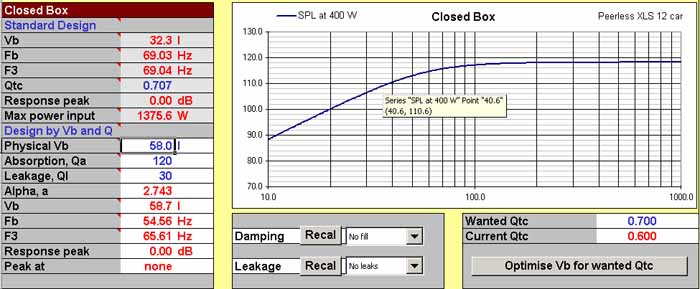
|
Another sealed box, this time a bigger 58l(2cf) giving a Q of 0.6, which has better transient response, a bit more low end response, and a tiny bit less midbass, and lower power handling, but for music, which usually doesn't go below 35hz, this normally isn't a problem. Unless your driver has very low excursion, but these XLS's have 13mm Xmax's (which is 26mm of fully linear excursion), and 44mm before the suspension bottoms out, so power handling is NOT a problem at all :) |
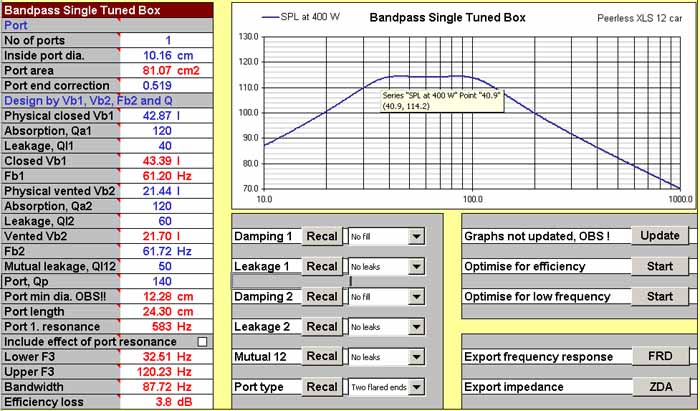
|
Another popular box; 4th order bandpass. 1 chamber sealed, 1 vented. In this case the sealed was 1.51cf, vented 0.75cf tuned to 61.72hz. Very wide bandwidth/passband (same meaning, different word), but the wider the passband, the worse the transient response becomes. This also means the smaller the bandwidth, the better the transient response is. |

|
Here's a bandpass design I made up. 1.59cf sealed and 1.24cf vented, tuned to 60hz. As you can see, this box would have more response in the 60hz region, which would be decent for most newer kinds of music since they have a LOT of output in that region, but the SQ guys would definetely balk at it :) |
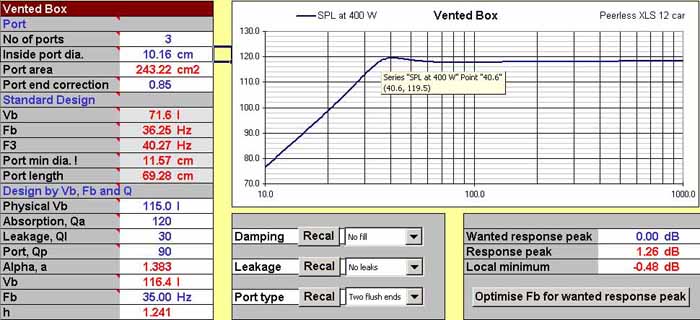
|
A largish 115l(4cf) vented box tuned to 35hz. A nice little rise of almost 1.5db around 40hz. This would make the sub sound very deep, and it'd probably be THE choice....if my friend wanted to give up 4cf....which he didn't. Another thing to note is that with bigger boxes, you need more port area than with smaller ones. Finally, they also have reduced transient response and sometimes may sound "flabby". |

|
A smaller 85l(3cf) vented box also tuned to 35hz. As you can see the slight bass peak is gone, and the response flatted out essentially. |

|
This is the box we chose to use. 58l(2cf) vented box tuned to 40hz. A bit less output at 40hz, but a bit more in the midbass region. Mainly though, the small size is very appealing. Also, 40hz can be considered the limit in how high you should tune to; anything higher and the sub would be risking more overexcursion (as the cone has very little control below tuning frequency), and there'd be even more of a midbass peak in our case. The port we chose was a 3inch wide x 13.5inch tall slot port (note that we used 3/4inch MDF, and the box height was 15inches, so you can see how we got the 13.5inch port height :)). Also the port was made out to be around 26inches, but due to the fact that the edges are straight, and they border on the edges of the box especially inside, the actual tuning frequency comes out a bit lower, I figure roughly around 38hz...further reducing the midbass peak and keeping the woofers under control a bit more. |
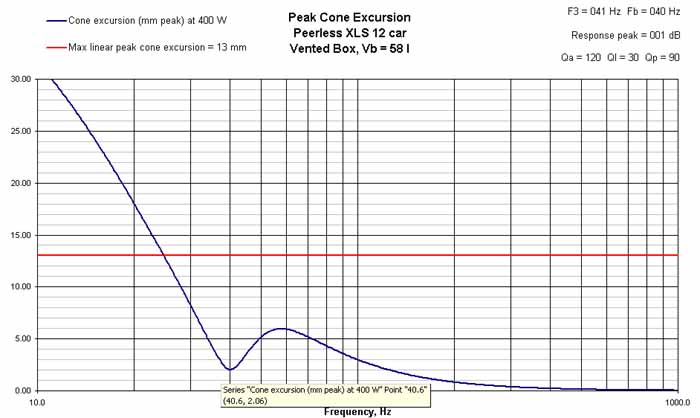
|
Here's the graph of what the actual cone excursion would be like. Note that the woofers suspension limits of 22mm each way (44mm total) mean that the woofer is safe until ~17hz.....only bass cd's really sweep that low, and that's on rare occasions. |
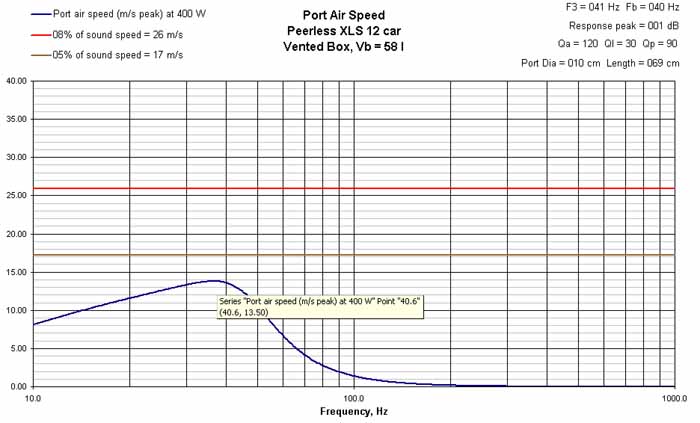
|
Here's what the port air speed is with the pretty big 3x13.5inch slot port. The less air speed the better; it means that the woofers dont have to work as hard to push the air out of the box, and because of that, transient response and sound quality as a general whole increase. Needless to say, the subs hit HARD, with no compression, well, only when the amp is past it's limits. |

|
This is what the impedance of a single driver would look like to the amp (they are wired to 1 amp channel each). Basically above 2ohms at any frequency the amp would normally ever see. |

|
Here's a comparo of the 3 boxes, the 38.2liter sealed box, the "custom" bandpass and the 58liter @ 40hz vented box. The vented box only has a little bit on the bandpass, and the fact that it's a bit easier to build than the bandpass made it another reason why we chose it. Also it'd be smaller :) |
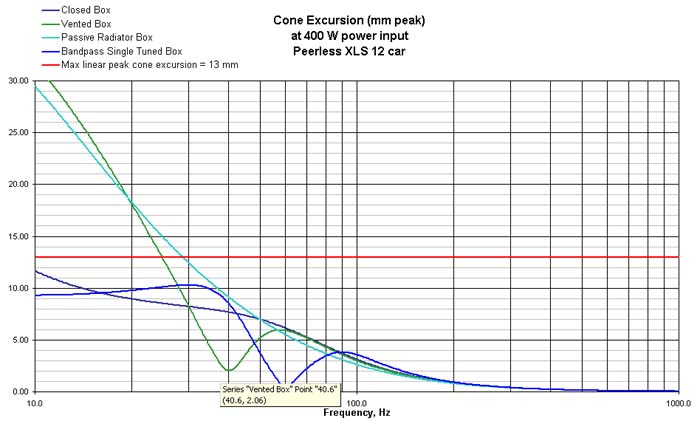
|
Excursions of the subs. Note the sealed boxes greater excursion @ 40hz, this would mean it would be able to handle more power than the vented, however it definetely wouldn't be able to put out the same SPL. Also note the bandpasses miniscule excursion @ it's 60hz tuning frequency, again, it wouldn't be moving much at all, so power handling might be a worry if we either had a really powerful amp, or poorly designed woofers....neither of which we have hehe. |
Well there you go, hope I didn't lose you along the way (feel free to email me with any question or comments).